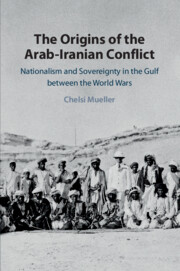 The Origins of the Arab-Iranian Conflict
The Origins of the Arab-Iranian Conflict Book contents
- The Origins of the Arab-Iranian Conflict
- The Origins of the Arab-Iranian Conflict
- Copyright page
- Contents
- Maps and Figures
- Acknowledgments
- Transliteration, Terms, and Conventions
- Maps
- Chronology of Major Events
- Introduction
- 1 States and Tribes in the Premodern Gulf
- 2 British Policy in the Persian Gulf between the World Wars
- 3 The Rise of Reza Khan and Iran’s Persian Gulf Policy, 1919‒1925
- 4 Reza Shah’s Persian Gulf Policy, 1925‒1941
- 5 The Trucial States, Iran, and the British
- 6 Bahrain, Iran, and the British
- Conclusion
- Appendices
- Glossary
- Bibliography
- Index
Conclusion
Published online by Cambridge University Press: 24 July 2020
- The Origins of the Arab-Iranian Conflict
- The Origins of the Arab-Iranian Conflict
- Copyright page
- Contents
- Maps and Figures
- Acknowledgments
- Transliteration, Terms, and Conventions
- Maps
- Chronology of Major Events
- Introduction
- 1 States and Tribes in the Premodern Gulf
- 2 British Policy in the Persian Gulf between the World Wars
- 3 The Rise of Reza Khan and Iran’s Persian Gulf Policy, 1919‒1925
- 4 Reza Shah’s Persian Gulf Policy, 1925‒1941
- 5 The Trucial States, Iran, and the British
- 6 Bahrain, Iran, and the British
- Conclusion
- Appendices
- Glossary
- Bibliography
- Index
Summary
The dramatic events of the interwar period constituted a watershed, separating millennia of interconnectedness and interdependency in the Persian Gulf from an era of geopolitical rivalry and Arab-Iranian conflict. Indeed, these two decades heralded the dawn of economic and political modernity in the Persian Gulf subregion. This period witnessed the collapse of the Qajar dynasty, the coming to the fore of Reza Shah Pahlavi and his assumption of the nationalist mantle, the introduction of nationalist policies into the Persian Gulf, and the incorporation of the Gulf Arab shaykhdoms into the Arab nationalist awakening. Reza Shah’s Iran took issue with Britain’s dominant position in the Gulf and rejected its claim to protect the Arab shaykhs of the southern littoral and strove to make Iran the main security provider in the Persian Gulf waterway. Iran’s ambition to gain sovereignty over the entire Persian Gulf region and regain territories of its former days was an ambition that resonated in the minds of many Iranian people. Iran’s bellicose policies also made a substantial and lasting impression on the rulers and inhabitants of the Gulf Arab shaykhdoms.
- Type
- Chapter
- Information
- The Origins of the Arab-Iranian ConflictNationalism and Sovereignty in the Gulf between the World Wars, pp. 229 - 241Publisher: Cambridge University PressPrint publication year: 2020
